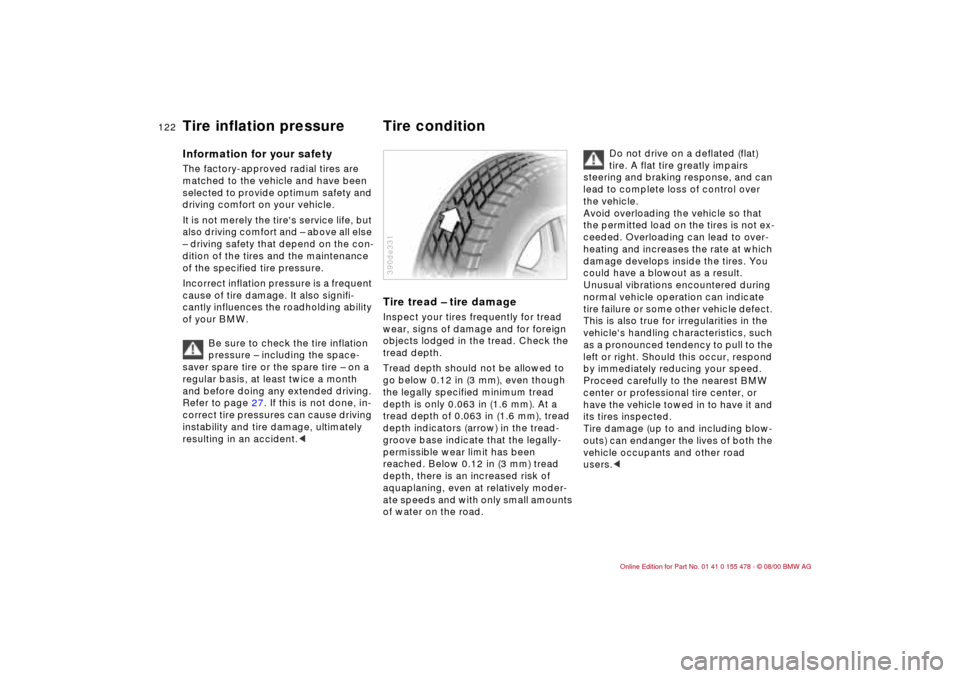2001 BMW 325Ci COUPE heating
[x] Cancel search: heatingPage 114 of 203

114n
Catalytic converter
Be sure to comply with the
preceding instructions to prevent
unburned fuel from reaching the cata-
lytic converter. If you do not, the cata-
lytic converter could respond by
overheating, leading to serious
damage.
Very high temperatures occur in any
vehicle equipped with a catalytic
converter. Heat shields are installed
adjacent to some sections of the
exhaust system. Never remove these
shields; do not apply undercoating to
their surfaces. When driving, standing
at idle, and parking the vehicle, take
extra care to avoid contact between the
exhaust system and flammable mate-
rials (grass, hay, leaves, etc.). Such
contact could lead to a fire, resulting in
serious personal injury and property
damage.<
Page 117 of 203

117n
IndexDataTechnologyRepairsCar careControlsOverview
Disc brakesDisc brakes furnish optimum decelera-
tion and braking control and greater
fade resistance under heavy use.
When the vehicle is driven only occa-
sionally, during extended periods when
the vehicle is not used at all, and in
operating conditions where brake appli-
cations are less frequent, there is an
increased tendency for corrosion of the
discs and accumulation of contamina-
tion on the brake pads. This occurs
because the minimal pressure that must
be exerted by the pads to clean the
discs by brake applications is not
reached.
If the brake discs are corroded, they will
tend to respond to braking with a
pulsating effect that even extended
brake applications will fail to cure.
For your own safety: use only
brake pads that BMW has
approved for your particular vehicle
model. BMW cannot evaluate non-
approved brake pads to determine if
they are suited for use, and therefore
cannot ensure the operating safety of
the vehicle if they are installed.<
Driving notesWhen driving in wet conditions and in
heavy rain, it is effective to apply light
pressure to the brakes every few miles
or kilometers. Be aware of traffic condi-
tions to ensure that this maneuver does
not endanger other road users. The
heat which is generated by the brake
applications helps to dry the brake
pads and discs.
Maximum braking force is obtained
while the wheels are not locked, but
rather when they are still barely turning
immediately prior to locking. ABS main-
tains this state automatically. If the
antilock brake system ever fails, you
should revert to pumping the brakes
(refer to page 120).
Extended or steep mountain descents
should be driven in the gear in which
only minimal periodic brake applica-
tions is required. This avoids excessive
strain on the brakes and possible
impairment of the braking effect.
You can further increase the engine's
braking effect by selecting a lower gear,
downshifting as far as first gear.
When driving a vehicle with automatic
transmission, you can still downshift
into first gear. Refer to page 67.If engine braking should prove to be
inadequate, you should still avoid
extended, continuous braking. Instead
of maintaining low to moderate pres-
sure over an extended period of time,
you should decelerate by applying
more substantial pressure to the brake
pedal (watch for following traffic),
releasing the pedal, and then repeating
the application (staggered braking). The
cooling phases between active braking
intervals prevent the brakes from over-
heating, thus ensuring that full braking
capacity remains available at all times.
Do not coast with the clutch
depressed or with the shift lever
or selector lever in Neutral. Do not drive
with the engine shut off. The engine
provides no braking effect when the
clutch is depressed or the transmission
is in Neutral, and there is no power-
assist for braking or steering when the
engine is not running. Never allow floor
mats, carpets or any other objects to
protrude into the area around the brake,
clutch or accelerator pedals, which can
obstruct pedal travel.<
Page 122 of 203

122n
Information for your safetyThe factory-approved radial tires are
matched to the vehicle and have been
selected to provide optimum safety and
driving comfort on your vehicle.
It is not merely the tire's service life, but
also driving comfort and Ð above all else
Ð driving safety that depend on the con-
dition of the tires and the maintenance
of the specified tire pressure.
Incorrect inflation pressure is a frequent
cause of tire damage. It also signifi-
cantly influences the roadholding ability
of your BMW.
Be sure to check the tire inflation
pressure Ð including the space-
saver spare tire or the spare tire Ð on a
regular basis, at least twice a month
and before doing any extended driving.
Refer to page 27. If this is not done, in-
correct tire pressures can cause driving
instability and tire damage, ultimately
resulting in an accident.<
Tire tread Ð tire damageInspect your tires frequently for tread
wear, signs of damage and for foreign
objects lodged in the tread. Check the
tread depth.
Tread depth should not be allowed to
go below 0.12 in (3 mm), even though
the legally specified minimum tread
depth is only 0.063 in (1.6 mm). At a
tread depth of 0.063 in (1.6 mm), tread
depth indicators (arrow) in the tread-
groove base indicate that the legally-
permissible wear limit has been
reached. Below 0.12 in (3 mm) tread
depth, there is an increased risk of
aquaplaning, even at relatively moder-
ate speeds and with only small amounts
of water on the road.390de331
Do not drive on a deflated (flat)
tire. A flat tire greatly impairs
steering and braking response, and can
lead to complete loss of control over
the vehicle.
Avoid overloading the vehicle so that
the permitted load on the tires is not ex-
ceeded. Overloading can lead to over-
heating and increases the rate at which
damage develops inside the tires. You
could have a blowout as a result.
Unusual vibrations encountered during
normal vehicle operation can indicate
tire failure or some other vehicle defect.
This is also true for irregularities in the
vehicle's handling characteristics, such
as a pronounced tendency to pull to the
left or right. Should this occur, respond
by immediately reducing your speed.
Proceed carefully to the nearest BMW
center or professional tire center, or
have the vehicle towed in to have it and
its tires inspected.
Tire damage (up to and including blow-
outs) can endanger the lives of both the
vehicle occupants and other road
users.<
Tire inflation pressure Tire condition
Page 180 of 203

180n
Self-diagnostics All of the important electrical and elec-
tronic systems in the vehicle are tested
regularly and automatically Ð the driver
does not have to perform any extra
operations or adjustments.
The indicator lamps come on briefly
after the ignition has been turned on.
While you are driving, the functional
status of the actuator motors (for the
windshield wipers, power windows,
seats, sliding/tilt sunroof, etc.) is
constantly being analyzed by electrical
measurements in the relays.462us038
In the same manner, the electrical
resistance of the airbag ignition genera-
tors and all of the remaining airbag
components is measured at all times.
Any fault in this system would be
detected immediately by a current fluc-
tuation that would necessarily accom-
pany it. The fault would be indicated
immediately by the airbag warning
lamp.
Even after you shut off the engine, the
overall functional status of your vehicle
is monitored. For example, all of the
flaps of the heating and ventilation
system travel to the nearest limit posi-
tion. This way you can be assured that
the defrost function is always available,
even if, for example, a defect crops up
in the air conditioner/automatic climate
control during the night while the
engine has been turned off.
A calibration cycle runs every tenth time
the engine is shut off. During this cycle,
the actuator motors of all the heating
and ventilation flaps travel to their limit
stops in both directions. The limit
positions and the return travel paths are
checked in this manner in order to
ensure that appropriate adjustments for
the operating elements can be made at
any time.You will hear the sounds of the air flaps
as the air conditioner/automatic climate
control carries out its self-diagnostic
functions after the ignition has been
shut off. All of the other self-diagnostics
functions operate silently in the back-
ground.
Any possible faults detected during
these self-diagnostics can be read out
and corrected by your BMW center
during the next regularly scheduled
maintenance.
Page 194 of 203

Everything from A to ZEngine oil135
adding135
capacity187
consumption135
level check135
pressure20
quality136
specifications136
viscosity136
Engine speed184
Engine, starting63
Engine, switching off64
Entry to the rear49
Exterior mirrors52
Eyelets, towing169 F
Failure messages77
Fault displays77
Fault, ABS116
Filling capacities187
Filling the washer
reservoir187
First-aid kit25
Fittings, towing and tow
starting169
Flashlight102
Flat tire122,159
Floor mat41
Floor panel, lift and hook41
Fog lamps88 Folding rear backrest106
Follow-Me-Home lamps87
Footbrake117
Footwell lamps88
bulb replacement158
Front fog lamps, bulb
replacement155
Front seat, adjusting47
Frost protection,
radiator137
Fuel27
Fuel consumption79
Fuel consumption
display76
Fuel filler cap26
Fuel filler door26
unlock in case of electrical
fault167
Fuel gauge76
Fuel quality27
Fuel reserve indicator
lamp76
Fuel specifications27
Fuel tank capacity187
Fuel tank gauge76
Functional status180
Fuses166
G
Gasoline27
Gasoline gauge76
Glove compartment102
Glove compartment lamp
bulb replacement158
Gross vehicle weight186 H
Handbrake65
Handsfree system104
Hazard warning flashers25
Hazard warning triangle25
Head restraints48
Headlamp cover,
care141,153
Headlamp flasher70,88
Headlamp washer
system72,134,187
Headlamps87
Heated seats101
Heating, rapid94
Heavy loads108
Height185
HiFi system Ð harman
kardon101
High beams23,70,88
bulb replacement153
High Performance Synthetic
Oil136
High-mount brake lamp157 Hood130
release130
Horn17
Hubcap161
Hydraulic Brake assistent,
refer to DBC
I
Ice warning79
Icy roads79
Identification,
tires125,127
Ignition key32
Ignition lock63
Imprint4
Indicator lamps20
Inflation
pressure27,85,122
monitoring27,85,179
INSPECTION76
Instrument cluster18
Instrument panel16,18
Instrument panel lighting87
Interaxle tire rotation124
Interface socket for Onboard
Diagnostics149
Interference, cellular
phones121
Interior lamps36,88
bulb replacement157
remote control36
Page 196 of 203

Everything from A to ZPDC (Park Distance
Control)81
Performance184
Pocket flashlight102
Pollen93,100
Power seat50
Power steering121
Power windows44
safety feature44
Pressure monitoring,
tires85,179
Pressure, tires27,122 Q
Quality Grades123 R
Radiator187
Radio Data System
(RDS)176
Radio reception121,176
Radio, refer also to the
separate Owner's Manual
Rain sensor71,178
RDC (Tire Pressure
Control)85,179
RDS (Radio Data
System)176
Reading lamps89
Rear backrest, folding106 Rear lamps155
Rear window
defroster72,92,100
Rear-entry assist49
Rearview mirror52
Recirculated air mode92
Reclining seat47
Refueling26
Remote control35
Removing condensation
from the windows94,99
Replacement keys32
Reporting safety defects7
Restraint system56
Reverse17,66
Roller blind, sun
protection101
Roof load capacity186
Roof-mounted luggage
rack109
Rubber parts119
S
Safety belt tensioner176
Safety belts55
height adjustment55
Safety buttons38
Safety feature44
Safety terminal, battery164 Seats47
adjusting47
electric power50
heating101
mechanical47
memory51
sitting properly58
Securing the load108
Selector lever, automatic
transmission67
Self-defrosting mirrors52
Self-diagnostics180
Service and Warranty
Information Booklet140
Service Interval Display76
Shiftlock67
Side airbags57
Side impact Head Protection
System57
Side lamps87
bulb replacement154
Sitting properly with
airbag58
Ski bag107
Skid control120
Sliding/tilt sunroof45
closing following an
electrical malfunction167
convenience operation34
Slippery roads119
Snow chains119,126 Socket105
for flashlights105
for power supplies105
for vacuum cleaner105
Spare key32
Spare tire159
Spark plugs188
Speaker104
Specifications, fuel27
Speed control75
Speed display18
Speed, average80
Speedometer18
Sports seat49
Starting assistance168
Starting
problems113,168
Starting the engine63
Steel rim127
Steering121
Steering lock63
Steering wheel52
adjusting52
Steptronic67
Stopping the vehicle64
Storage compartments102
Storage facilities102
Storing your vehicle147
Stroke184
Summer tires125,127
Sun roller blind101
Sun visors53